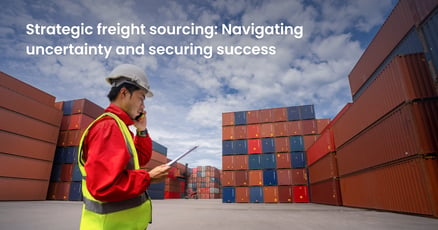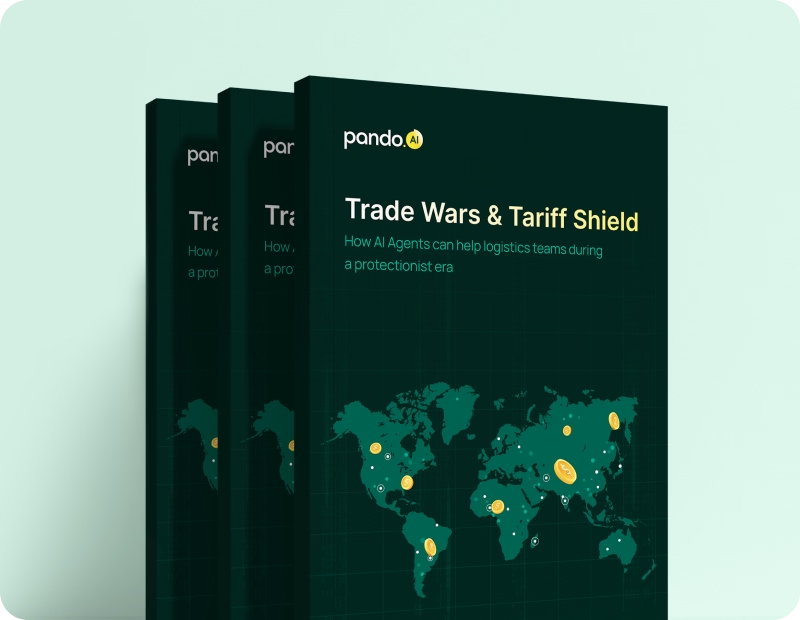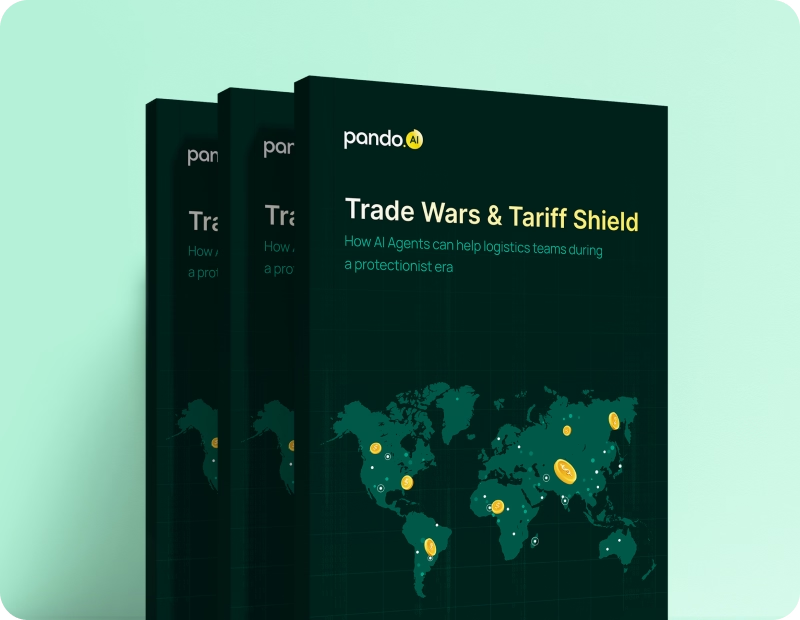-
Products Products
- Industry
- Initiatives
- Resources
- Company
- Book a demo

Before you go: Logistics leaders just dropped the truth on AI
The State of AI in Logistics 2025 is here — no hype, just real conversations and raw insights.
Understanding freight rates: Hidden factors that impact shipping costs
Fluctuating freight rates tend to impact your shipping costs. See how AI/ML-backed solutions can help you optimize your shipping costs.
Published on December 13, 2024 • 15 mins read
Rohit Lakshman

Fluctuating freight rates tend to impact your shipping costs. See how AI/ML-backed solutions can help you optimize your shipping costs.
The global logistics market was valued at approximately $9.83 trillion in 2022 and is projected to reach about $16.79 trillion by 2032. Since freight rates are tied to transportation — a critical component of the supply chain — they significantly influence the overall cost of goods and the profitability of the supply chain. Transportation costs can amount to about 60% of total logistics costs.
When a product or shipment has to be transported, the cost or freight rate involves several complex elements—base shipping costs, fuel and security surcharges, accessorial charges, and customs fees and duties are a few of them.
Managing these rates efficiently can help companies maintain a competitive edge by controlling operational costs and optimizing delivery times.
What influences freight rates and shipping costs
More than 10 distinct factors influence freight rates — and each of those can cause shipping costs to fluctuate dramatically. Understanding how these factors affect freight pricing is essential for shippers to control their logistics budget.
Here is a detailed explanation of the key factors influencing freight costs and their corresponding impacts.
1. Fuel costs
The most significant cost driver in transportation is fuel. When fuel prices increase, carriers pass on this cost to shippers through fuel surcharges. Conversely, freight rates may temporarily decrease when fuel prices drop, but the decline is often less dramatic than the increase during fuel spikes. According to the U.S. Energy Information Administration (EIA), diesel prices can fluctuate dramatically, leading to frequent adjustments in freight rates.
This is why fuel volatility is one of the most unpredictable factors affecting freight rates. In 2022, fuel surcharges increased by 20–30% due to a global surge in oil prices. It created upward pressure on the overall shipping costs.
Fuel surcharges are typically calculated based on a formula that considers current fuel prices compared to a baseline. For example, if the current fuel cost is $5.25 and the baseline is $3.00, the surcharge would be calculated based on the difference, significantly impacting the overall shipping cost.
2. Seasonal demand
Seasonal peaks, such as the holiday season, harvest periods, or back-to-school times, often lead to increased demand for freight capacity. As demand spikes, carriers charge premium rates — an increase of 20–40% over the base rate — to shippers needing immediate transportation. During off-peak periods, carriers may reduce rates to ensure they fill capacity.
3. Capacity constraints
When transportation capacity is tight—whether due to economic factors, driver shortages, or disruptions like natural disasters—freight rates tend to spike. A lack of available trucks, ships, or planes results in carriers prioritizing higher-paying shipments, which drives rates upward. Tight capacity results in higher freight rates as shippers compete for limited carrier space. Additionally, the costs can increase further due to premium surcharges for urgent shipments during constrained capacity periods.
4. Cargo characteristics
Freight rates also depend on the size, weight, and type of cargo being shipped. Larger, heavier, or more cumbersome shipments take up more space and resources, increasing the costs to transport them. Similarly, hazardous or temperature-sensitive goods may require special handling, further driving up rates.
5. Distance and route
Distance between the origin and destination of a product is another huge factor that influences freight rates. Longer distances generally lead to higher shipping costs; however, specific routes can also impact rates. Routes passing through congested or difficult terrain can increase costs due to longer transit times, tolls, and additional taxes. According to the Journal of Commerce, port congestion surcharges during the 2021 crisis ranged from $150 to $500 per container, depending on the carrier and route.
Similarly, international routes that are particularly sensitive to geopolitical risks, tariffs, and customs fees can add hidden costs to freight rates.
6. Exchange rates
The rate of exchange is another significant contributor to determining the freight rate. When a company is shipping across borders, the strength of its domestic currency versus the currency in the destination country can affect the final shipping costs. A weakened U.S. dollar against the Euro could increase the cost of shipments from the U.S. to Europe.
7. Geopolitical events
Political instability, trade wars, and sanctions can disrupt trade routes, thereby impacting freight rates. During the U.S.-China trade war in 2019, tariffs led to increased shipping costs as companies had to reroute goods or face higher customs fees. Similarly, Russia’s invasion of Ukraine in 2022 caused severe disruptions in Europe’s logistics networks, contributing to higher shipping rates due to route changes and fuel price hikes.
Additionally, the Houthi rebel attacks in 2021 and 2022 worsened the Red Sea crisis, further disrupting freight, particularly for shipments passing through major maritime trade routes such as the Suez Canal. The heightened security risks in the region led to vessel diversions, which extended transit times and contributed to higher operational costs. Capacity constraints grew as vessels were forced to take longer routes around Africa to avoid conflict zones, further inflating ocean freight rates during this period.
8. Government regulations and compliance
Government regulations, such as emissions standards, driver hours of service (HOS) restrictions, and safety mandates, can influence carrier operating costs, which are then passed on to shippers. New environmental regulations can lead to higher operating costs for ocean carriers.
The IMO’s 2020 sulfur cap regulation increased shipping costs for ocean freight as carriers switched to more expensive, low-sulfur fuel, resulting in surcharges of up to 50% for certain shipments.
9. Carrier competition and market conditions
In regions where there is high competition among carriers, freight rates tend to be lower. Conversely, in markets with few available carriers or limited transportation options, rates can be significantly higher. Market conditions, including mergers or acquisitions among carriers, can also lead to changes in rates. MSC, the world’s largest ocean freight company, set new rates for 40-foot containers to the U.S. West Coast, charging between $8,000 and $10,000 in May 2024.
10. Accessorial fees
Accessorial fees are additional charges for services beyond standard transportation, such as liftgate deliveries, inside deliveries, and detention fees. FreightWaves' survey reveals that accessorial fees can make up as much as 25% of total shipping costs in some industries, especially in retail and e-commerce, where special delivery needs are common.
For instance, detention fees, which are imposed when a truck is held beyond the allotted loading or unloading time, can cost as much as $50-100 per hour, adding substantial expenses to a shipper’s bill.
11. Technology and Automation in Freight
As carriers and logistics providers increasingly adopt automation and technologies like AI, robotics, and blockchain, the level of digital sophistication within the supply chain drives freight rates. AI-powered route optimization can reduce fuel consumption and travel time, potentially lowering shipping costs. Talking about the capabilities of an AI-enabled TMS, Gaurav Patel, Warehousing Expert, Castrol said this of Pando, “It (Pando) helps plan efficient routes and consolidate loads, reducing fuel consumption and improving resource utilization."
Additionally, blockchain technology helps reduce fraud and errors in billing, making freight rates more transparent and manageable.
12. Natural disasters and climate change
Natural disasters, such as hurricanes, floods, or wildfires can disrupt transportation routes and capacity, leading to sudden spikes in freight rates. Climate change is expected to make such events more frequent, affecting logistics networks globally. During Hurricane Milton in 2024, freight rates in the affected areas surged as carriers faced significant disruptions, fuel shortages, and capacity issues.
Methods of calculating freight rates
Freight rates are determined using various methods, depending on the mode of transportation, shipment characteristics, and market conditions. Here are the common methods for calculating freight rates, along with their formulas.
1. Per mile or per kilometer rate
Freight carriers often charge based on the distance between the origin and destination of the shipment. This is common for trucking and road freight.
Formula:
Freight Rate = Rate Per Mile (or Kilometer) × Total Distance
Example: If the rate is $2 per mile and the distance is 500 miles:
Freight Rate=2×500=1000USD
2. Weight-based Rate
Carriers may charge based on the weight of the shipment, especially for air and rail freight. The rate is determined per unit weight, such as per pound or kilogram.
Formula:
Freight Rate = Rate Per Unit Weight × Total Weight
Example: If the rate is $0.50 per pound and the shipment weighs 2,000 pounds:
Freight Rate=0.50×2000=1000USD
3. Volume-based rate (Dimensional weight)
For light but bulky shipments, carriers may use dimensional weight (or volumetric weight) in pounds rather than actual weight. Dimensional weight accounts for the space the shipment occupies.
Formula:
Dimensional Weight (lbs) = Length (in) × Width (in) × Height (in)
Dimensional Factor
The dimensional factor is often 139 for domestic shipments and 166 for international shipments (in inches).
Example: For a package measuring 24 in x 18 in x 12 in, using a dimensional factor of 139:
Dimensional Weight = 24X18X12
139
= 37.2lbs
The freight rate would be calculated based on this dimensional weight if it exceeded the actual weight.
4. Flat rate
Flat rates are commonly used for specific routes or services where a standard charge applies, regardless of distance or weight. This simplifies the process but may not always be the most cost-effective for all shipments.
Formula:
Freight Rate = Flat Rate
Example: If a flat rate of $1,200 is agreed upon for shipping between two cities, the rate remains constant, regardless of weight or distance.
5. Zone-Based Pricing
In zone-based pricing, the freight rate depends on the shipment’s origin and destination zones. The rates are usually predefined for shipments between specific zones. The U.S. Postal Service (USPS) and some courier companies use this method for parcel shipments.
Formula:
Freight Rate = Rate for Zone Pair
Example: Shipping from Zone 1 to Zone 5 may have a predefined rate of $50 for a particular package size.
6. Freight Class Calculation (for LTL Shipments)
Less-than-truckload (LTL) carriers use freight class to determine the rate based on factors like density, stowability, handling, and liability. The National Motor Freight Classification (NMFC) assigns a class ranging from 50 to 500.
Formula for Density (used to determine freight class):
Density (lbs per cubic foot) = Weight (lbs)
Length (ft) × Width (ft) × Height (ft)
Example: For a shipment weighing 500 lbs and measuring 4 ft x 4 ft x 4 ft:
Density = 500
4×4×4
= 7.81 lbs per cubic foot
The freight class would be determined based on this density, and the rate would vary accordingly.
Get ahead of freight rates with AI
All these factors that influence freight rates can be daunting. To manage your logistics costs successfully, you need to anticipate and prepare for these changes. Fortunately, with AI (Artificial Intelligence) and Machine Learning (ML)- enabled solutions, you can automate a huge chunk of your operations, such as real-time rate benchmarking, predictive freight rate forecasting, automated invoice auditing, and payment verification.
With the integration of AI, these processes become more organized, data-driven, and resilient to market volatility.
1. Shipper-carrier relationship
When you have a strong relationship with carriers, you can navigate market volatility. However, building loyalty in your carriers requires work. One surefire way to do this is to be on the same page. Keep open channels for sharing shipment details and promptly notify carriers of any changes.
Timely payments are decisive in your carrier relationship trajectory. If you pay them promptly, they are more likely to prioritize your shipments. Also, for better collaboration, keep the carrier informed with accurate forecasts so that they can plan their capacity effectively, reducing the chances of delays or over-commitment.
Working closely with carriers on route optimization and scheduling ensures that both parties benefit from efficient logistics. Pando’s TMS allows you to exchange information in real time on a unified platform. We offer a frictionless UI with mobile apps for stakeholders, improving collaboration in shipment execution and allowing for freight rate transparency.
The platform tracks carrier performance and maintains a historical record to allow for data-driven decision-making around carriers. It helps you provide feedback while recognizing their efforts and fosters a positive working relationship.
Flexibility and shared benefits also go a long way in maintaining a strong partnership. Being adaptable during disruptions, such as weather events or market fluctuations, helps carriers feel supported while allowing them to share in the savings from cost-cutting initiatives.
Providing consistent freight volumes and ensuring fair load distribution across carriers further reinforces trust. For example, retailers who maintain stable, long-term contracts and reward carriers for meeting performance goals create a sense of partnership that extends beyond transactional business dealings. This approach ultimately leads to more reliable, mutually beneficial relationships with carriers, ensuring smooth operations for both sides.
2. Diversify carrier network
Relying on a single carrier increases the risk of exposure to price volatility, service disruptions, and capacity shortages. Freight solutions such as rate management, audit, and payment software provide real-time insights into market conditions and allow companies to make informed decisions about when and with whom to ship their goods.
These AI-driven tools offer advanced features such as dynamic pricing analysis and real-time alerts on rate changes, helping you stay competitive. You can use spot procurement opportunities and automated workflows to secure the best carrier rates, optimize carrier selection, and drive cost savings.
These systems offer automated recommendations for cost-saving opportunities, ensuring companies get the most value from your freight spend. With automated 4-way invoice matching and online dispute management, invoice reconciliation and dispute resolution are seamless, further enhancing the efficacy of your logistics cost management.
3. Negotiate contracts during off-peak seasons
Freight rates are typically lower during off-peak seasons when capacity is abundant and demand for transportation services is reduced. Shippers can take advantage of this by negotiating long-term contracts when rates are more favorable. AI tools can identify optimal times to engage in contract negotiations by forecasting market conditions based on historical data, seasonality trends, and real-time supply chain data like weather patterns or regional disruptions.
For shippers in the automotive industry, AI can monitor historical freight rates and market demand cycles. It can identify freight rates are consistently lower at specific months from historical data. The shipper can use this insight to negotiate a contract extension with its primary carrier, locking in lower rates for the next year.
4. Hidden fee and predictive analysis
AI not only helps you track fuel price trends and surcharges but also gives you detailed data by breaking down shipping costs and detecting hidden fees, such as detention or demurrage charges, that you might otherwise overlook. Automated audits compare invoices with actual shipment data, ensuring billing accuracy. You can recover costs efficiently, reducing the risk of overcharging and giving you greater control over your shipping expenses.
AI's predictive capabilities also suggest the most efficient transportation modes to help you stay ahead of demand shifts that could increase costs. Pando’s optimal mode selection solution analyzes factors such as cost, service levels, transit time, and environmental impact and then recommends whether you should shift from air to ocean freight or use intermodal transport.
You can automate mode selection for specific orders using pre-set workflows, making the process seamless. Additionally, you can take advantage of rate-shopping tools to compare different mode options and choose the most optimal solution for your needs.
You can then adjust strategies—such as rerouting shipments or prebooking capacity—to avoid inflated costs during peak periods, ultimately improving both cost-effectiveness and efficiency.
Lower freight costs, higher profits with Pando
Pando’s solutions facilitate the identification and management of hidden shipping costs by leveraging automation, real-time insights, and predictive analytics. Pando’s TMS (Transportation Management System) provides extensive, real-time visibility into shipment movements, allowing you to detect operational inefficiencies, such as delays or suboptimal routing, that may contribute to increased costs. Additionally, it promotes load consolidation, thereby minimizing unnecessary trips and associated expenses.
Moreover, Pando’s Freight Audit and Payment (FAP)system enhances invoice accuracy through automated audits, effectively identifying hidden fees, such as detention or demurrage charges. You can automate invoice matching and expedite the resolution to prevent overcharges. Moreover, its cost forecasting capabilities support more informed budgeting and long-term cost management strategies.
Don’t miss out on the opportunity to boost your bottom line.
Book a demo with Pando today and see how we can transform your supply chain with intelligent automation and actionable insights!
Subscribe to Pando blog and Crossroads newsletter now!
Stay up to date with the latest logistics, transportation, and supply chain tips and news.
Subscribe Here!

Related blogs
Strategic freight sourcing in volatile market conditions: How to navigate uncertainty and secure competitive rates












